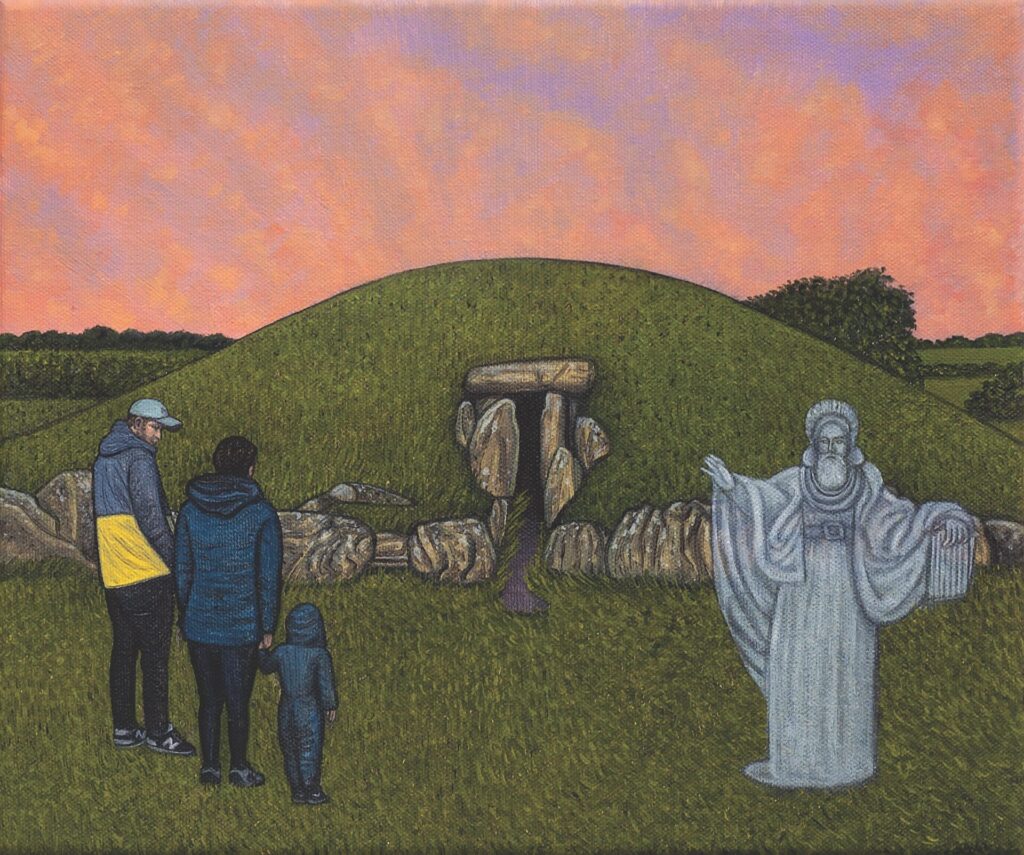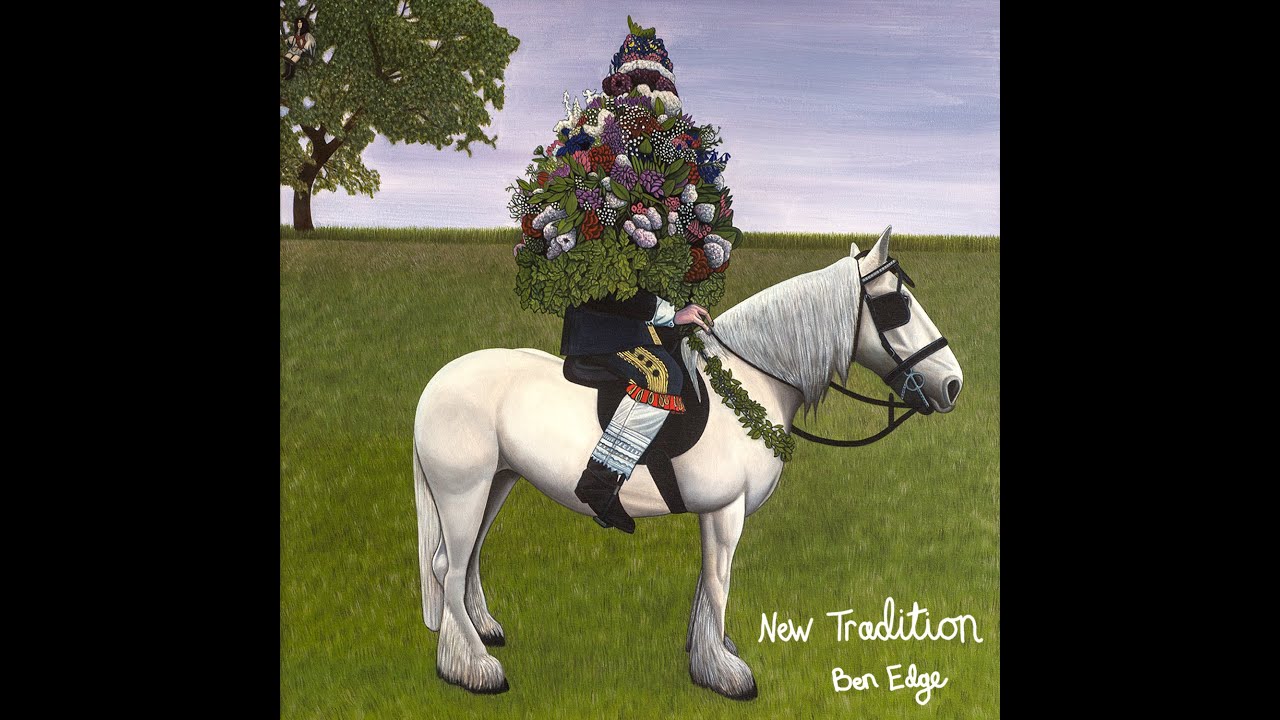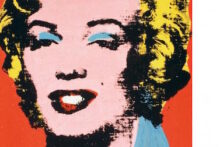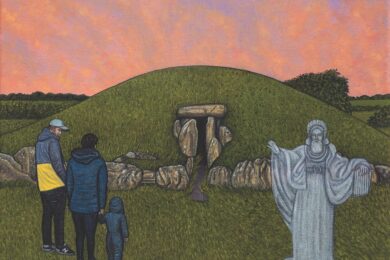This journey began when I was going through a bout of severe depression and had begun taking long walks through the streets of London in an attempt to reconnect myself with the outside world, and the history and folklore of the city. This, I had hoped, would inspire new paintings and gradually help me out of the dark days that I had been experiencing. Little did I know that my life was about to change for ever.
It was a spring morning and I had made the decision that I would approach the Ravenmaster at the Tower of London, with the intention of asking him whether I could paint his portrait. It is the Ravenmaster’s job to ensure that there is a healthy raven population within the walls of the Tower at all times. It is said that if there are any less than six, then the crown would fall and the Tower with it.
As I arrived at Tower Hill tube station, and walked out into the busy road, I could see in the distance a group of people processing in a line, draped in white cloaks. Completely unbeknown to me, it happened to be the day of the Spring Equinox, the time of year when night and day are of equal length, and the long darks days of winter are behind us and the long bright days of summer are now on the horizon. A notion that soon became a metaphor for my own life.
As I approached, the group had assembled into a circle outside the All Hallows by the Tower church and began what appeared to be some kind of ancient ritual. There was talk of the harvest, reconnecting with the land, and that one day London itself would be reclaimed by nature. Something about the experience shifted my psyche immediately. I had been stuck in a constant loop of negativity and had completely forgotten who I was. Hearing a group of contemporary people slap bang in the middle of the city amongst the gleaming glass buildings, a KFC and red phone box, who were taking the time to honour the seasons, set new intentions for the year and to plug into something much larger themselves without the dogma of an organised religion was just what I needed. An experience that I now call in hindsight my ‘Druidic epiphany’.
I raced home and looked into exactly what it was that I had just witnessed, and it turned out to be London’s very own ‘Druid Order’ that were soon to be celebrating their 300th birthday, and by discovering them I discovered a whole network of what are known as seasonal folk customs taking place across Britian – whether it was the Obby Oss of Padstow, a large cylinder beast like creature, with a tribal looking mask that danced in the coming of Summer on May Day, or the Horn Dancers of Abbots Bromley that rutted back and forth holding ancient reindeer antlers to ensure a successful harvest, with the horns themselves carbon dated back to 1665. My mind had been completely blown and I was compelled to start visiting as many of these remarkable events as I possibly could. A healing journey of self-discovery, recovery and inspiration had begun.
Over the next decade, I would travel by bus, train, and foot, finding myself wandering down unpaved roads as lorries and traffic passed, nearly rattling me into the bushes. This was all part of the excitement of the journey for me, and here are some of the tracks that I listened to throughout, which became the soundtrack to these folkloric adventures.
During this time, I also wrote an album called New Tradition that was released by Glass Modern records in 2021, In which I was also directly inspired my experiences within the folkloric realm.
Daniel Patrick Quinn, ‘The Burryman’ (featuring Duncan Grahl)
The second I heard the drone of the intro I was completely entranced and totally hooked. Then, as Duncan Grahl comes in, a sixty-year old warder of the National Gallery of Scotland, who begins telling the story of the folk tradition of South Queensferry, The Burryman. The song not only captured the mystery and magic of the tradition itself, but it is also a really funny and addictive listen. Daniel Patrick Quinn, a renaissance man, who deserves a lot more credit for his incredible body of work, is not only a musician and a prolific songwriter, but also a writer, whose ebook on the The Dorset Ooser (I’ll explain more about the Ooser later) was a great resource for me whilst writing my own book, and is another must for all folklore fans.
The Corries, ‘Highland Lament’
This song is just beautiful in every way and transports me to another place. The sound of the bagpipes and the harmonies of the singing; the pain and heartbreak of the lyrics of the Jacobite widows, forced out of their rural communities due to poverty, after losing their husbands in the battle of Culloden. The song itself can be traced back to the 1700s and the tune itself even further back.
Elspeth Anne, ‘Mercy Me’
One of the greatest privileges that I have experienced whilst travelling across Britain is hearing all the thriving folk music that often accompanies the traditions themselves. On one particular trip to Herefordshire to see Blackthorn Ritualistic Folk perform a wassail ceremony, I came across the mesmerising voice of Elspeth Anne who performed a Lankum song, ‘Hunting the Wren’. This was all taking place amongst the wassail itself, where the Darkest Ooser, a modern manifestation of the Dorset Ooser (the mysterious horned beast that you can see in my painting on the front cover of my book), roamed through smoke machines amongst other folk beasts. It was a special moment, and on my return home I went through Elspeth’s whole incredible back catalogue that she has since added to. I am particularly in love with this witchy, eerie song, ‘Mercy Me’ from her latest album.
The Singing Loins, ‘House in the Woods’
My original journey into music was playing punk music, and the band that I played in throughout my twenties, Thee Spivs, were lucky to be on the same label (Damaged Goods) as Medway’s finest, The Singing Loins. I became obsessed with their music quite early on in my teens and have never stopped listening to them; they play folk music in such an authentic raw punk kind of way and have made endless great albums. It was real a tragedy and loss to music as a whole when their singer Chris Broderick passed away in 2022, but his legacy lives on through his songs that are still performed by the group today, and whose latest album twelve was recently released on Damaged Goods records. This song I love, in particular, as it captures that feeling of yearning for the simple life and it feels like medicine when I’m feeling overwhelmed by the hectic nature of modern London living.
Battlefield Band, ‘Lovers and Friends’
On my first visit to the Burryman as I travelled through Edinburgh, I popped into a record store and asked the man at the counter, “What’s your favourite Scottish folk band?” He straight away pulled out a stack of Battlefield Band records and insisted that I began with the Best Of, before venturing into their album releases. So, I took his advice and fell in love straight away. The song ‘Lovers and Friends’ has been a song that I have been regularly listening to ever since. The song tears into the corruption of the church whilst promoting drinking that will “surely appease procreation”. A perfect song and listening to it on the way to see the Burryman for the very first was the perfect soundtrack.
Syd Barrett, ‘Bob Dylan Blues‘
This is another of those songs that has been with me for years, and a song I love to listen to whilst travelling. There’s something about the romance of being a travelling Bob Dylan-esque type character that has always appealed to me, so when I listen to Syd Barrett singing the ‘Bob Dylan Blues’ I feel like I’ll get to live that fantasy for a short time at least… well, for three minutes and thirty-three seconds. There’s also something really philosophical and thought-provoking about Syd Barrett’s delivery of the song that I find especially addictive.
Ivor Cutler, ‘Life in a Scottish Sittingroom 2 Episode 11’
In this song, Ivor Cutler reminisces over a family walk from his childhood in Scotland, and paints a vivid picture of the Scottish countryside, Here, we meet a turnip seller on a donkey, childhood games of battering each other with thistles whilst shaking hands and dancing to his father’s bagpipes. It’s a beautiful song that is a great introduction if you aren’t aware of the genius of Ivor Cutler.
Angeline Morrison, ‘Black John’
A track from the modern classic, The Sorrow Songs by Angeline Morrison, where lost voices of Black British history are brought to life through this collection of beautiful and often harrowing songs. We have heard the stories and oppression of Black British people through genres such as ska, reggae and hip hop, but never before have we heard a collection of songs that capture the Black British experience through traditional folk music. This, to me, gives this trail-blazing album an added layer of importance, whilst delivering great songs, such as this one, ‘Black John’, that tells the story of an eighteenth-century gardener, who was recently honoured as UK’s first known Black horticulturalist. Angeline also has a new album Ophelia that I highly recommend.
Billy Childish and the Singing Loins, ‘I don’t like the man that I am’
From the album, ‘At The Bridge’, which is one of my favourites. Not only do we see the coming together of two greats of the Medway delta, Billy Childish and The Singing Loins, but we get a collection of songs that for me is one of the best folk albums ever made. I love the self-loathing lyrics mixed with the optimistic and uplifting sounding backing track. A perfect song.
The Dubliners, ‘Thirty Foot Trailer’
The song the ‘Thirty Foot Trailer’ captures the demise of the traditional travelling rover lifestyle, originally written by Ewan MacColl, and sung by many folk greats since, but my favourite version has to be by the Dubliners, whose Irish accents suit the song and subject matter perfectly and give you a sense of the tragic loss of an age-old way of life.
Folklore Rising by Ben Edge is published by Watkins







